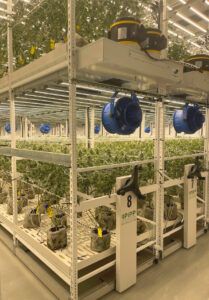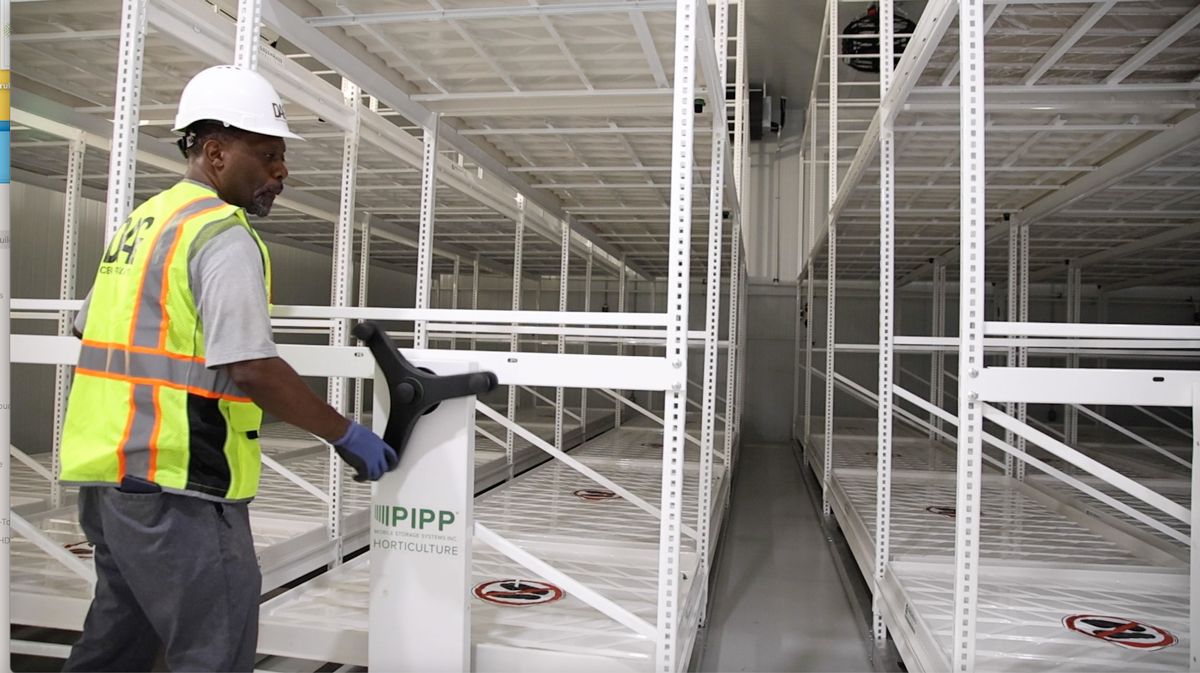When it comes to cannabis, Dominion Builders’ Agricultural Group (DAG) is redefining the way Controlled Environment Agriculture (CEA) facilities are designed, built and operated. As a leader in the burgeoning indoor agriculture industry, the company known as “The Grow Facility Company is empowering growers by delivering end-to-end solutions that take projects from concept to harvest.
With expertise in foundational planning, integrated growth systems, preconstruction services, construction and commissioning, DAG eliminates the complexities of creating innovative, cost-effective growth environments.
DAG is more than just a builder—it is a collaborator, problem-solver and visionary. Its extensive experience and hands-on approach ensure every grow facility is tailored to meet each client’s unique needs. From the first blueprint to the final crop, DAG partners with growers to bring their vision to life, delivering high-performing facilities that enhance efficiency, sustainability and profitability.
Operating as a division of Dominion Builders, DAG is backed by more than 45 years of construction expertise, with projects spanning diverse sectors like hospitality, healthcare and agriculture. Along with Dominion Builders, it is offering a comprehensive approach to construction, uniting innovation and practicality to meet the demands of the modern agriculture industry.
We sat down with founder and CEO Mark Gemignani to get his take on the cannabis market heading into 2025.
Give us a snapshot of your company.
Dominion Builders, a privately owned commercial general contractor, operates from Coral Gables, Florida, and is licensed across the U.S. and Canada. With more than 45 years of industry expertise, Dominion’s management team has built an award-winning portfolio that showcases exceptional craftsmanship, teamwork, and a lasting impact on real estate communities.
Dedicated to delivering top-tier commercial construction and renovation projects, Dominion serves a select group of clients with a focus on quality and innovation. One of Dominion’s core specialties is Controlled Environment Agriculture (CEA) facilities for food crops, reflecting its commitment to sustainable and efficient agricultural solutions.
Dominion’s specialized division, DAG – The Grow Facility Company, focuses exclusively on the cannabis industry. DAG is a recognized leader in the planning, design and construction of state-of-the-art CEA facilities tailored for cannabis cultivation. From concept to harvest, DAG offers a full range of services, including strategic planning, integrated preconstruction, construction and commissioning.
What type of businesses are you targeting?
Regarding DAG and our cannabis clients, we work with mid-sized to large multi-state operating (MSO) Cannabis companies that want a high-performing cultivation facility. They tend to be business and performance-oriented and understand that it takes intense planning and leadership to deliver the right facility for the right budget on time.
What are some key design factors you consider when building one of these cultivation facilities?
Operational efficiency and maintenance are generally overlooked. Trying to retrofit the wrong building gets expensive and causes delays. It is important to begin with exactly how you want to grow, how much yield you want to achieve and what are your optimal growing conditions.
From there we work on the floor plan and equipment layouts that consider optimizing workflow, minimizing contamination, and ease of operation.
What kind of services do you offer for Controlled Environment Agriculture facilities?
We offer four integrated stages to ensure the most efficient and effective way to execute and build the facility. It starts with Foundational Planning (Phase I) which considers layout, budget, yield and feasibility as a cost-friendly conceptual package. From there we move to Preconstruction (Phase II) where we lead in the integration of all systems and select, vet, and coordinate all teams.
We competitively bid all subcontractors, drive the project to final permitted construction documents and enact any necessary early procurement. Then we move to Construction Project Organization & Management (Phase III). We are the general contractor providing on-site supervision and procurement management.
We establish weekly meeting schedules, project submittal and request for information (RFI), change tracking systems, and obtain any pending approvals required by landowners and regulatory agencies. Project Close-out (Phase IV) is where we procure a certificate of occupancy from the authority having jurisdiction. We provide closeout manuals, guarantees and warranties, operations manuals and the “record set“ of construction documents.
What is your short-term strategy? Long-term?
Our short-term strategy is to design and build the most effective cannabis cultivation facilities in the industry. Our long-term strategy is to set the standard for cannabis facilities and be the number one company for the development, design and construction of CEA facilities.
What is the best piece of advice you can offer to other companies today?
Find a niche and commit to it. Learn everything about the industry and implement constant improvements and innovation throughout the process.
A common mistake that companies run into is building the facility to operate based on one cultivator. It is important to understand how to properly scale a facility for efficiency.
What are a few ways that companies can get the most out of their cultivation facility with planning and design?
Be thoughtful and patient throughout the planning process—know how much your facility is going to cost to execute your dream. Build a strong team of experts in cultivation, operations and maintenance. Don’t get too caught up in the latest and greatest gadgets, focus on standard operating procedures and operating your facility efficiently.
What are a couple of common mistakes companies run into when designing their cannabis facilities?
A common mistake that companies run into is building the facility to operate based on one cultivator. It is important to understand how to properly scale a facility for efficiency. Rather than designing the facility and then forcing the equipment to fit in it, we recommend designing your equipment layout and designing the facility to encompass it.
Give us a rundown of your market’s layout.
Fifty-percent are blind enthusiasts. These are craft growers with know-how, but lack business acumen and funding. Five-percent are diligent debutantes—sophisticated business people who instill confidence, have a strong business plan and are well or self-funded.
The others include:
- 30% Master on the Scene: Large companies that want to do it themselves.
- 5% Grow it Yourselfers: Farmers that are used to doing everything themselves.
- 10% Achievers: New license holders that have strong business plans and funding, and know-how.
 What’s the biggest issue today related to the construction side of the business?
What’s the biggest issue today related to the construction side of the business?
The biggest issue we run into on the cannabis side is a lack of funding and banking and the slow movement of the government to reclassify cannabis.
Talk about sustainability. What are you doing?
We aim to build efficient operations that consider water usage, drainage, efficient lighting and power usage efficiency.
What type of opportunities do you see moving ahead?
As new license holders emerge in the eastern U.S., our focus is on creating the standard for designing and building the best operating facilities in the country.
What trends are you seeing/expecting?
The players who are now involved in cannabis are looking to build solid long-term businesses. Industry consolidation and maturation will begin to separate the Blind Enthusiasts from the Diligent Debutantes.
What is the secret to creating an ideal cultivation facility in today’s competitive landscape?
Right-size it to your company’s goals. Be future-proof and consider good manufacturing practices.
Tell us what makes your brand so unique.
Our intense focus on developing cultivation facilities, our commitment to the industry, and our relationships with top experts and people throughout the industry are what sets us apart from other companies.
Describe a typical day.
A typical day involves an early-morning hour at Starbucks for a coffee and catching up on the news, followed by a quiet hour of organization and critical thinking. Fast-track to balance the day typically including 100% communication in the various forms with clients and staff; emails, phone calls, internal meetings and video conferences. Always manage to take a breather at 11:30 for a meal and casual conversation. Closure typically includes a glass of wine and dinner with my wife.
What’s the biggest thing on your to-do list right now?
The biggest thing on the list is the recruitment of some key positions on the team.
What was the best advice you ever received?
My wrestling coach in high school demanded the concept of “never give up.” That attitude not only allowed me to win in sports, but it has also guided me to persevere through difficult times throughout my business career.
What’s the best thing a client ever said to you?
I had a client tell me that they appreciated the interaction with our firm mainly due to the stellar culture that they experienced from top to bottom. Of course the quality of our work is excellent, but the experience is what will bring them back for more.
View the original article and our Inspiration here


Leave a Reply